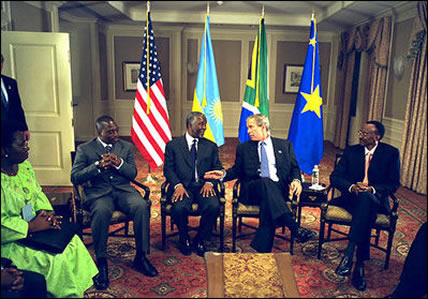
Photograph by Hjalmar Gislason
The current conflict between the M23 rebels and the Congolese army cannot be completely understood without recollecting the history of the genesis of conflicts in this region of great lakes. Here is a detailed chronology of the last 50 years of confrontations in this region.
On Congo Forum, Jacques Mbokani wrote [fr]:
Since the DRC became independent , it has been prey to all kinds of conflicts. … … The presentation is mainly focused on identifying the causes of the conflicts in the DRC. …The causes of the conflicts in the DRC can be grouped into two main categories. …external causes … and, on the other hand, internal causes.
The Congo was declared independent on June 30, 1963, and renamed Congo-Leopoldville. Power was shared between the head of state Joseph Kasa-Vubu and the Prime Minister Patrice Lumumba. On November 25, 1965, supported by governments of Belgium and the United States, GeneralJoseph Desire Mobutu deposed President Kasa-Vubu, removing him from power and naming himself president of the Democratic Republic of Congo. He would remain in power for 30 years. The country was renamed Zaire between 1971 and 1997.
This video covers the history of the assassination of Patrice Lumumba [fr]:
Another video tells of the coming to power of Mobutu, King of Zaïre, Conquest of Power [fr]:
Important economic issues at stake
Jacques Mbokani continued [fr]:
In the film entitled “Blood Diamond”, an old man sighs in these terms: “I hope that they’re not going to find oil… then we really will be in danger…”. The words of the old man reveal the real question about natural resources as sources of conflict.
On the website Maps of the DRC [fr], we learn that:
Often called a “geological scandal”, the subsoil of DRC is bursting with various minerals and enormous reserves of energy. The most well-know mining resources are those of clusters of tin, nobium and copper, to which we can also add manganese, gold and diamonds. As for energy wealth, we can point to the oil off-shore in the Atlantic, and to major deposits in the north east, which have already stimulated many appetites within the Mafia-like underworld, as much Congolese as international, to the disgust of local people. Also, uranium from the south east of the country, as well as methane gas from Lake Kivu, make up part of the energy resources that the country cannot seem to manage properly right now or in the future. This lack of authority and control of its own wealth, betrayed by unprecedented trafficking operations in the east of the country, controlled by armed gangs with, unhappily often, the complicity of the Congolese themselves to the detriment of their own country.
The causes of the internal conflicts within the DRC date from the dictatorship of Joseph-Désiré Mobutu, who remained in power until 1997:
The strongest reason was the best, … mediocrity of the political class, … the collapse and the lack of independence of the judiciary …non-existence of public services, both administrative and social. … The recruitment of soldiers, be it by the standard process or within the framework of brewing or mixing, this recruitment is done without taking account of the citizens, of the times, of morality or of the judicial past
The following video shows the hold that Mobutu had over the DRC during this period: Mobutu, King of Zaïre 2, Master of the Game [fr]:
Website Konexinfo [fr]traced how several countries found themselves implicated in this conflict:
The current situation in the DRC, in the Kivu region follows from several conflicts which took place over twenty or so years in the African great lakes region. These many conflicts are all linked to one another. New warlords take over from those who have acceded to power.
Seven countries at war on Congolese soil

Meeting between Kabila, Bush, Kagame and Annan at NYC in 2002. Photograph by Eric Draper
The Ugandan Yoweri Museveni recruited and organised an army of 6,000 men at the frontiers ofTanzania, Rwanda and Uganda and overthrew the elected president of his country, Milton Obote in1986.
In Rwanda between 1990 and 1993 the FPR with Paul Kagamé at its head fought against the regime of the sole party of the president, Juvénal Habyarimana.
In 1994, the genocide in Rwanda, which has a common border with the DRC, forced around 2 million people to migrate to Eastern DRC.
From Zaire to the Democratic Republic of the Congo [fr]and to the current chaos, website la documentation francaise gave a detailed chronology [fr]of events in the DRC:
In 1996, in South Kivu, the Banyamulenge rebellion started, involving Congolese Tutsi of Rwandan origin (who had migrated to the region from 1959 to flee the violence in Rwanda), with the military support of Rwanda, Uganda and Burundi. With others opposing the president of Zaire, Marshall Mobutu, they regrouped as the Alliance of Democratic Forces for the Liberation of Zaire, ADFL, led by Laurent Desire Kabila.
After 30 years of power, President Mobutu left in exile before the rebels’ victory. Laurent Desire Kabila named himself president of the Democratic Republic of the Congo (DRC), the new name for Zaire. The rebels took control of capital Kinshasa on May 17, 1997.
Dismantling the camps of Rwandan refugees infiltrated by former Rwandan armed forces and extremist Hutu militia – the Interahamwe – responsible for the genocide of 1994 in Rwanda.
Kabila then broke his alliances with Rwanda, Uganda and Burundi.
In 1998, a new Tutsi rebellion, among the Banyamulenge broke out in Kivu against Kabila’s government troops, supported by his ex-allies Rwanda and Uganda. A new political-military coalition was formed – the Congolese Assembly for Democracy (RCD) – led by Ernest Wamba dia Wamba.
Seven countries at war on Congolese soil, with Congolese rebels supported by Rwanda, Uganda and Burundi….capturing Kisangani, capital of the Eastern province and the country’s third city. They would be stopped in their advance towards Kinshasa by the intervention of troops from Angola, Namibia and Zimbabwe.
This resulted in the partitioning of the country, with North and South Kivu falling under the control of the RDC and the West remaining under the control of Kabila and his allies Angola, Namibia and Zimbabwe.
Also in 1998, another rebellion, this one led by Jean-Pierre Bemba, in the province of Equator, the Movement for the Liberation of the Congo (MLC), took control of the region. With the support of Uganda, they took the city of Kindu and the mining regions of Kasai and Katanga.
On May 17, 1999, Wamba’s RCD split into two movements: RCD-Goma, led by Emile Ilunga Kalambo and supported by Rwanda, and RCD-Kisangani, which remained under Wamba’s control, and was supported by Uganda. Uganda were also still supporting Bemba’s MLC.
Kabila’s government no longer controlled the western half of the country.
The Lusaka Ceasefire Agreement (Zambia), signed in July 1999, changed nothing with respect to the massacres. The Rwandan army occupied one part of the Eastern province, North and South Kivu as well as North Katanga. The Ugandan army controlled the north parts of Equator and Eastern provinces. Despite the agreements, fighting and massacres continued. Both countries disputed control of the city of Kisangani, global hub of the diamond market, leading to the death of two hundred citizens.
In 2001, following the assassination of President Laurent Desire Kabila, his son Joseph Kabila was named head of state, on January 17.

Countries directly or indirectly involved in Congolese Conflicts. Graphic by Jaro7788
Since then, United Nations resolutions and peace agreements between aggressors and attempts at democracy have periodically punctuated the repeated massacres and rapes as a weapon of war. The cyclical conflicts have allowed foreign powers and companies to access the precious minerals[fr]so vital to mobile phones worldwide.
Jacques Mbokani concluded [fr]:
In summary, the central cause resides in the failure of the Congolese state which must be rebuilt. It is because the state no longer exists that neighbouring states steal, rape and do whatever they want. It’s because the state no longer exists that there has been a proliferation of warlords and of heavy weapons.
Written by Anna Gueye and translated by Jane Ellis




